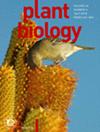Linking phylogenetic niche conservatism in bacterial communities in sorghum root compartments revealed by the Hongyingzi cultivar
IF 4.2
3区 生物学
Q1 PLANT SCIENCES
引用次数: 0
Abstract
红营子栽培品种揭示的高粱根区细菌群落系统发育生态位保守性的联系
根系蕴藏着复杂的细菌群落,对植物的生长和健康至关重要。根系中的细菌群落之间存在显著差异;然而,对高粱根系中细菌群落的系统发育组成和生态位保守性的研究报道却很有限。我们以高粱红营子栽培品种为试验植株,应用 16S rRNA 高通量测序和多种统计方法,对高粱根系中的细菌群落进行了系统发育组成和生态位保守性研究。根区细菌群落的系统发育组成主要由具有相似环境适应性的近缘种驱动。我们还发现了细菌群落系统发育生态位保守性的证据,即不同根区的环境因子,pH 值和可利用氮在形成群落组成方面起着至关重要的作用。环境阈值分析揭示了优势类群对 pH 值和可利用氮的阈值范围,表明更丰富的类群有更宽的适应阈值。对祖先状态的重建表明,某些细菌类群对环境因素的适应性在进化过程中发生了变化,向微酸性、高氮环境转变,反映了栽培土壤中细菌与植物之间长期的相互影响。这些发现加深了我们对高粱幼苗根系相关微生物群的环境响应和进化动态的理解,并为生态适应提供了新的见解,揭示了它们对环境因素的响应。我们的研究有助于更好地理解根相关微生物群的生态动态,并为探索根微生物群的营养调控提供了分析途径。
本文章由计算机程序翻译,如有差异,请以英文原文为准。
求助全文
约1分钟内获得全文
求助全文
来源期刊

Plant Biology
生物-植物科学
CiteScore
8.20
自引率
2.60%
发文量
109
审稿时长
3 months
期刊介绍:
Plant Biology is an international journal of broad scope bringing together the different subdisciplines, such as physiology, molecular biology, cell biology, development, genetics, systematics, ecology, evolution, ecophysiology, plant-microbe interactions, and mycology.
Plant Biology publishes original problem-oriented full-length research papers, short research papers, and review articles. Discussion of hot topics and provocative opinion articles are published under the heading Acute Views. From a multidisciplinary perspective, Plant Biology will provide a platform for publication, information and debate, encompassing all areas which fall within the scope of plant science.
 求助内容:
求助内容: 应助结果提醒方式:
应助结果提醒方式:


